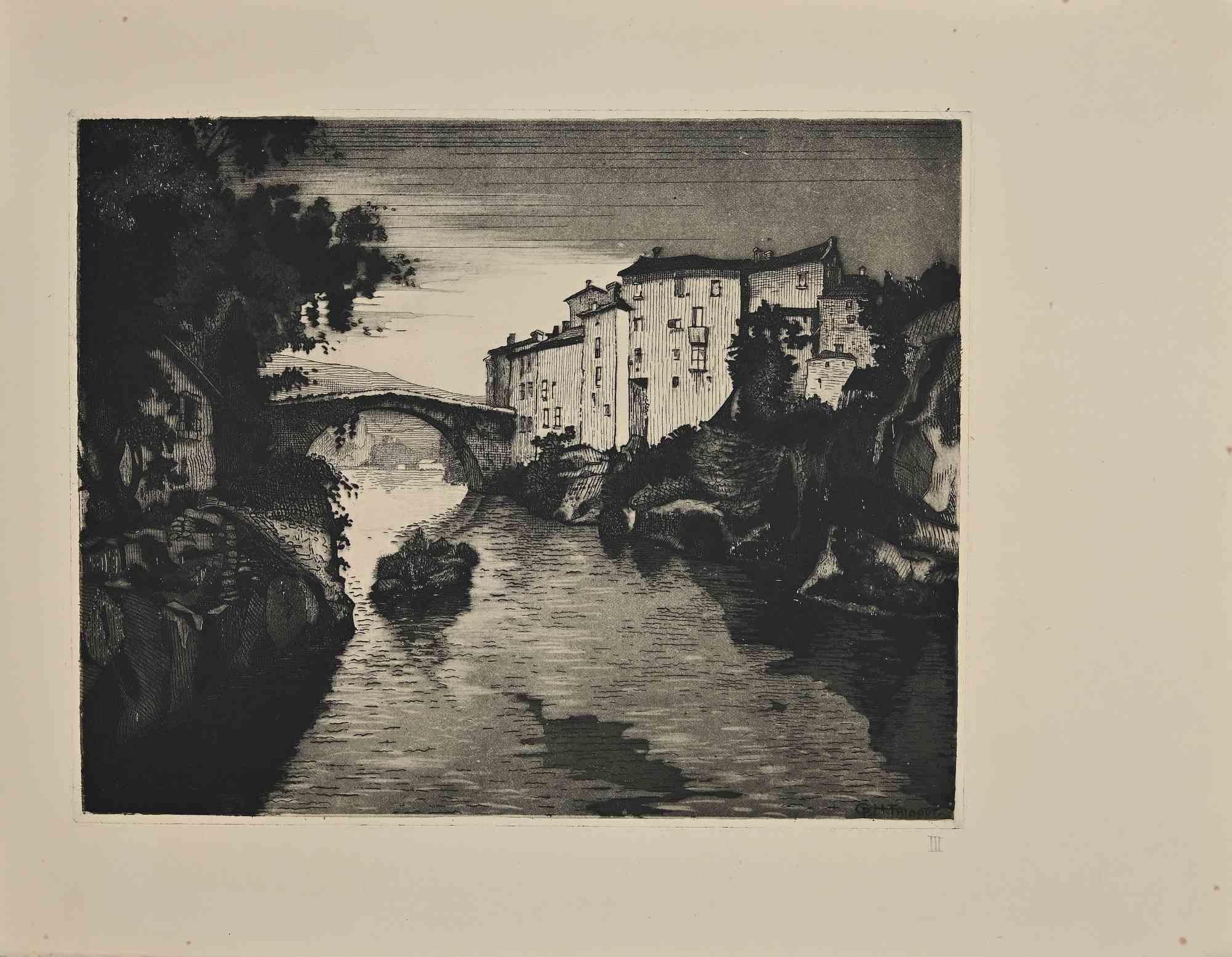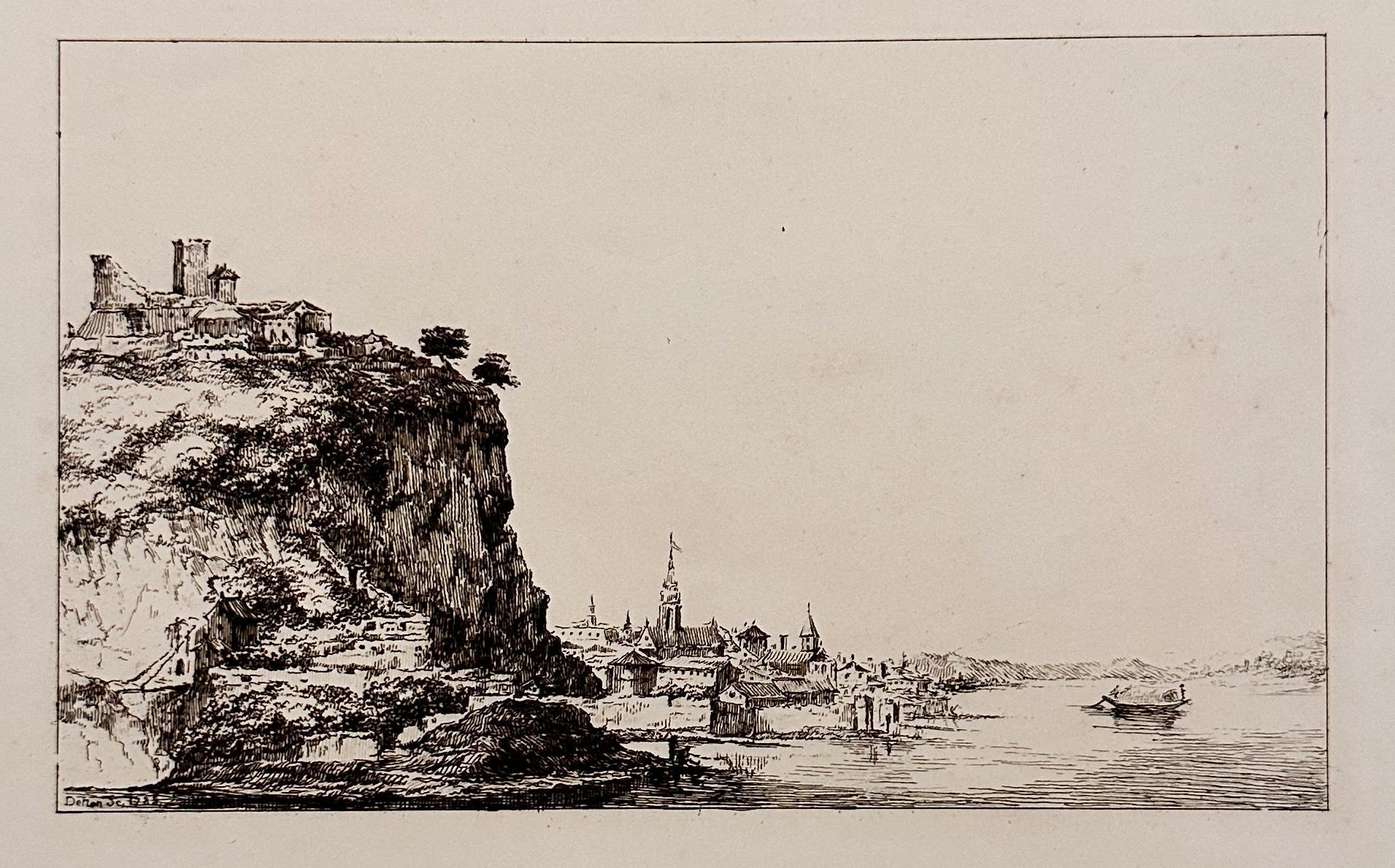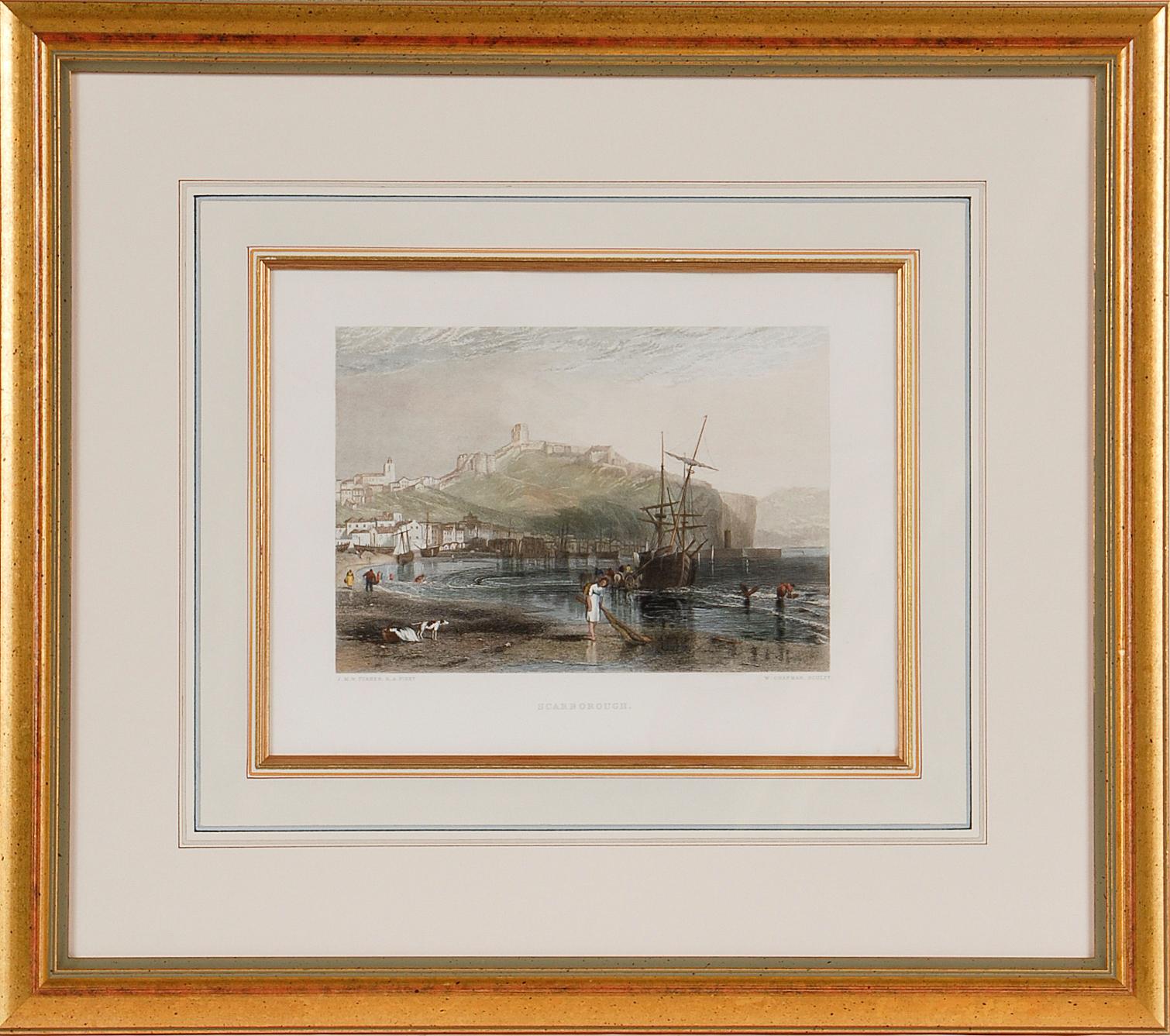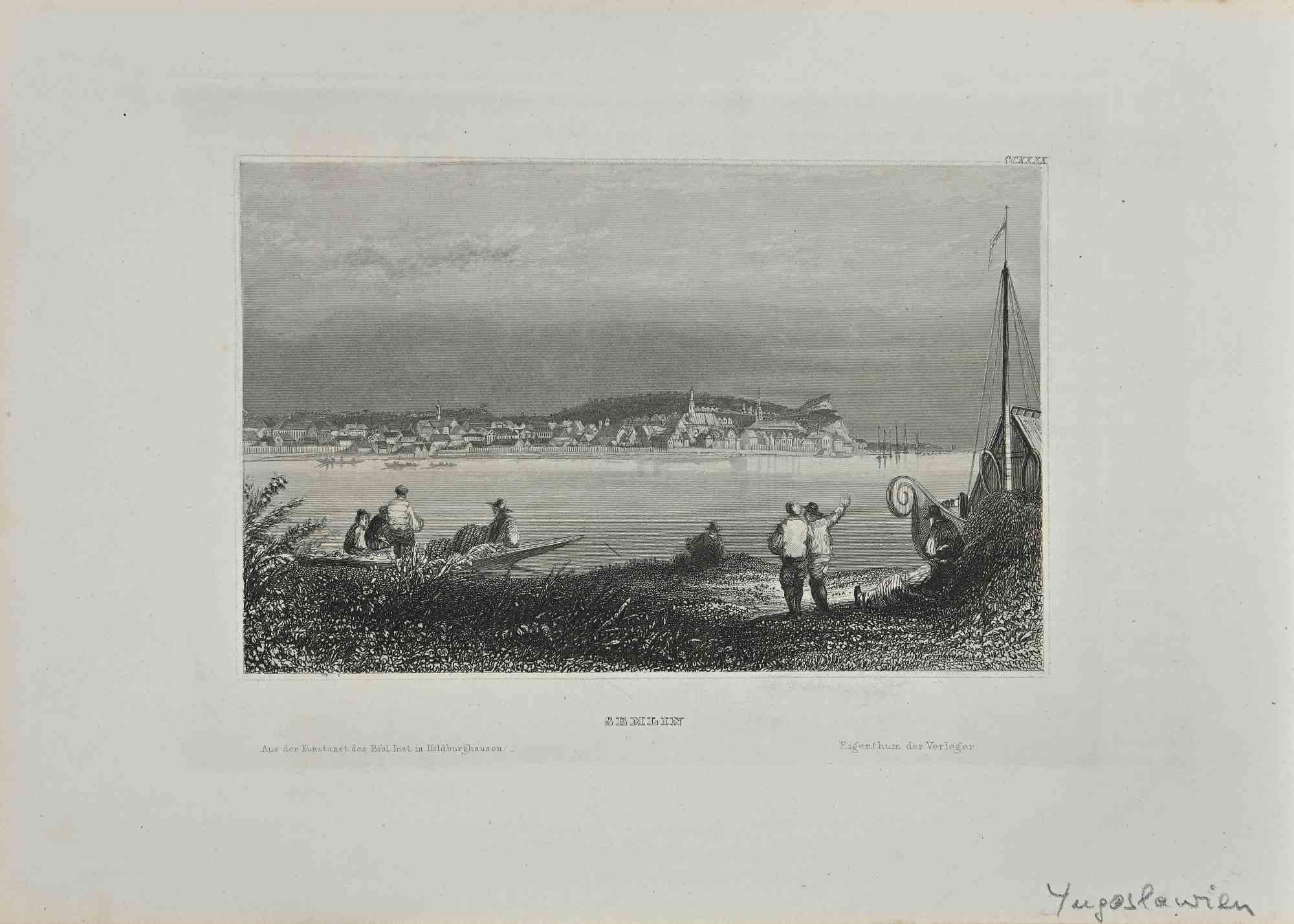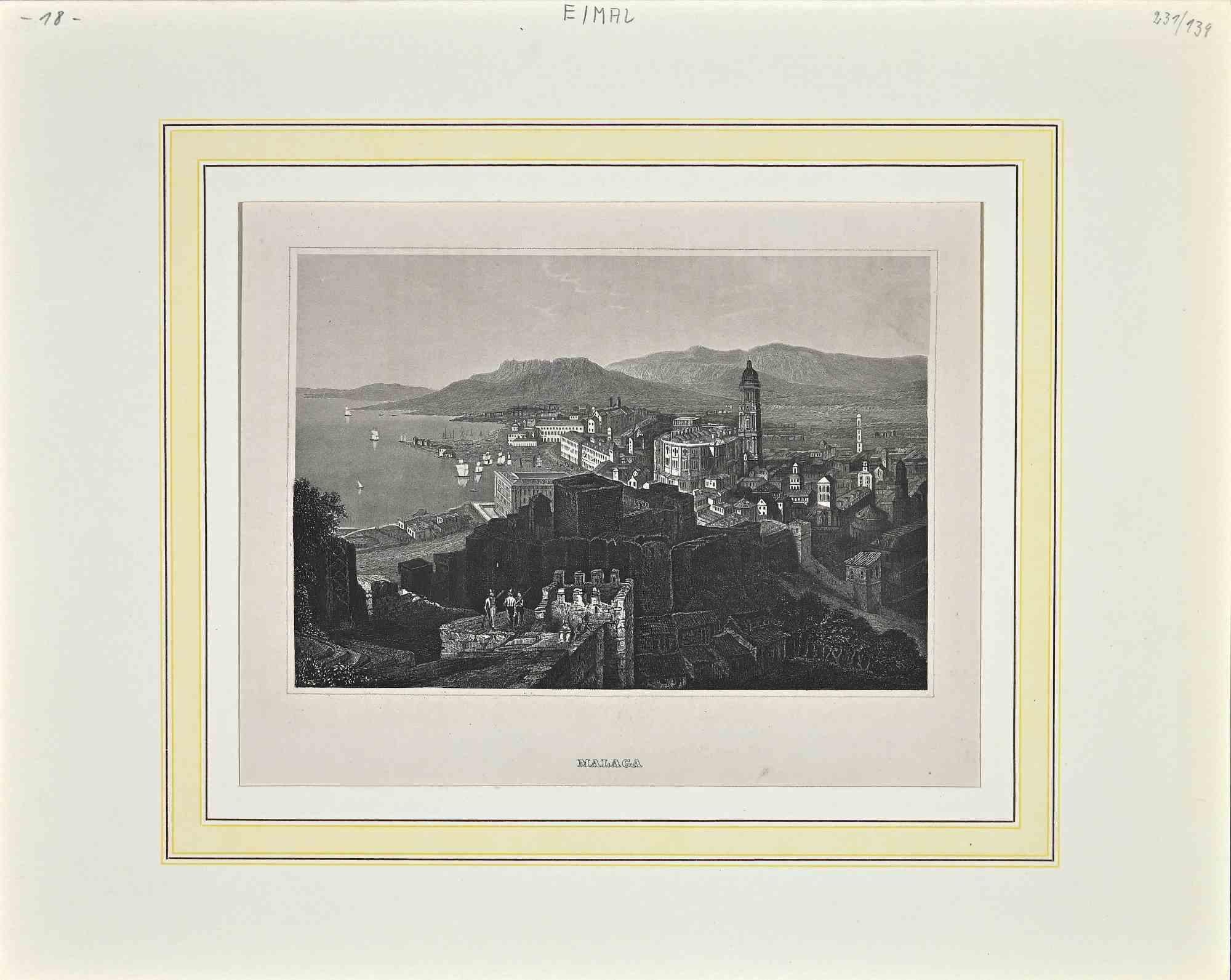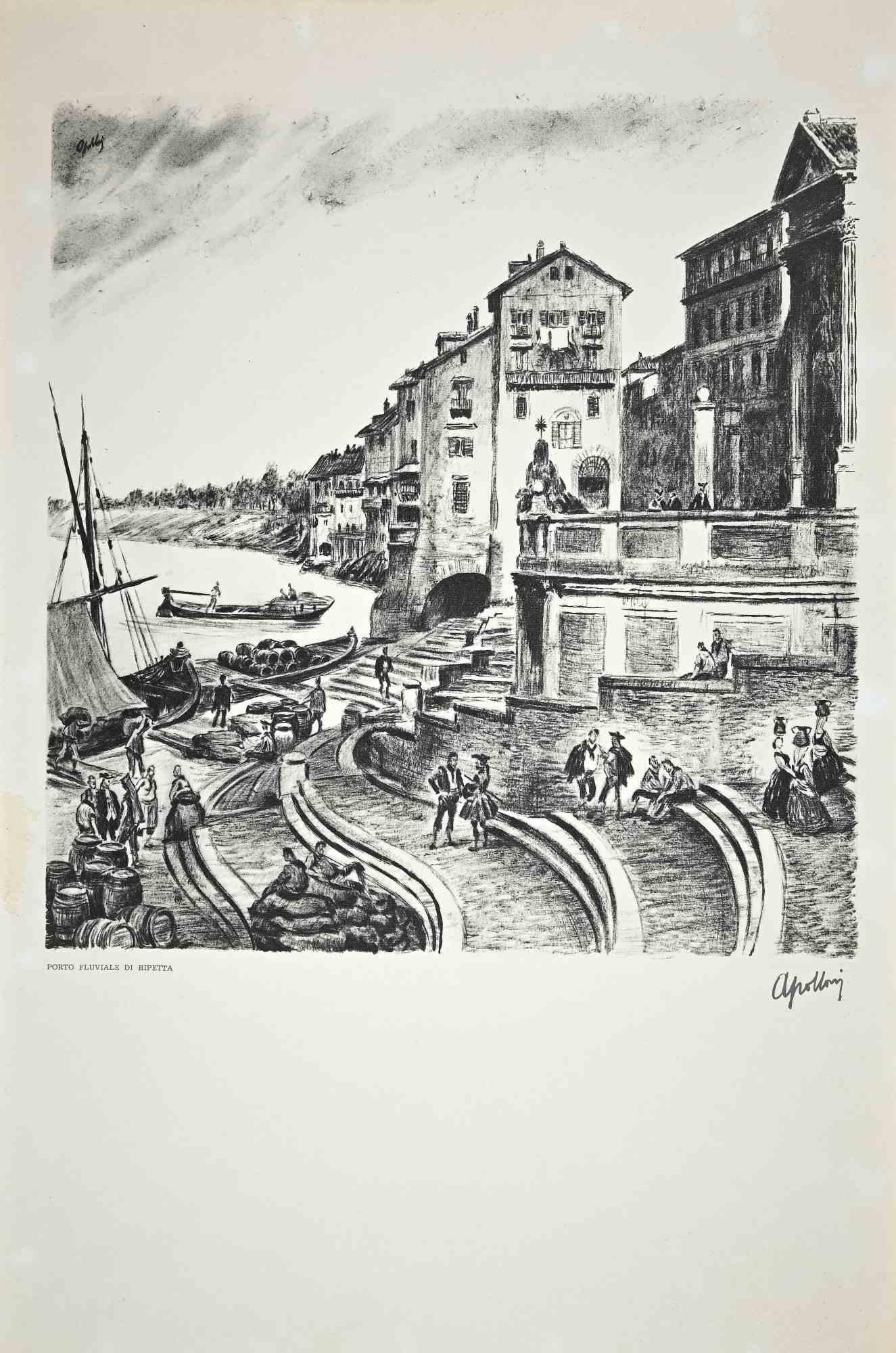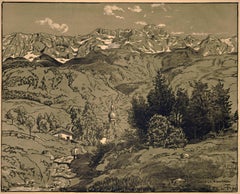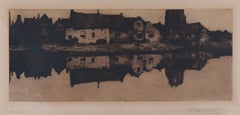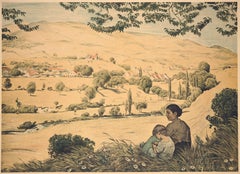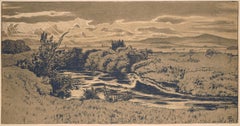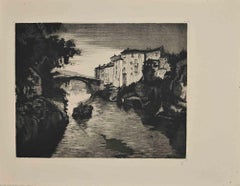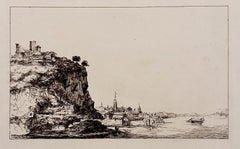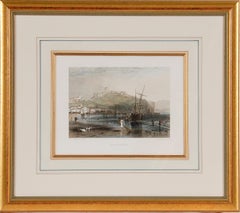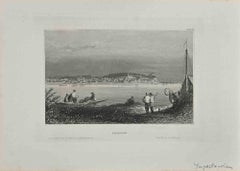Items Similar to View of a coastal town / - The Pilgrim's View -
Want more images or videos?
Request additional images or videos from the seller
1 of 8
Albert ErnstView of a coastal town / - The Pilgrim's View -
$232.94
$291.1720% Off
£176.46
£220.5720% Off
€200
€25020% Off
CA$322.70
CA$403.3820% Off
A$361.93
A$452.4220% Off
CHF 189.54
CHF 236.9220% Off
MX$4,397.86
MX$5,497.3320% Off
NOK 2,406.84
NOK 3,008.5520% Off
SEK 2,281.85
SEK 2,852.3120% Off
DKK 1,522.75
DKK 1,903.4420% Off
About the Item
Albert Ernst (1909 Fronhofen - 1996 Hamburg), View of a Coastal Town, etching, 30 x 37 cm (picture), 45 x 50.5 cm (frame), signed in pencil lower right "Albert Ernst", framed under glass.
- very good condition and attractively framed
- The Pilgrim's View -
About the artwork
Standing on a hill, we look at a bay with a town. The foreground of the picture is only slightly worked out, so that our gaze is completely absorbed in the view framed by trees. Up to the middle of the picture, the landscape is kept in a darker tonality, while the city appears brighter and the sea really shines. This brightening in the distance also focuses the view and makes the seaside city a place of longing. Accordingly, on closer inspection, we can make out a pilgrim in front of the dark thicket, walking from the foreground of the picture along the dark, hollow path that leads to the city. As the goal of his pilgrimage, a mighty church tower rises in the center of the picture, from which the shore of the sea on the other side and thus the goal of the pilgrimage of life may be recognizable.
About the artist
Albert Ernst studied at the Academy of Applied Arts in Munich from 1932-1936 and was an assistant there from 1936-1941. He then worked as a freelance graphic artist, first in Munich until 1950 and then in Hamburg. In Hamburg he was also commissioned to design church windows for sacred buildings in Steilshoop, Bramfeld and Stellingen from 1977-1979.
Selected bibliography
Sauer. Allgemeines Künstler-Lexikon, Vol. 34, Munich - Leipzig 2002, p. 444.
GERMAN VERSION
Albert Ernst (1909 Fronhofen - 1996 Hamburg), Blick auf eine Küstenstadt, Radierung, 30 x 37 cm (Darstellung), 45 x 50,5 cm (Rahmen), rechts unten in Blei mit „Albert Ernst“ signiert, im Passepartout unter Glas gerahmt.
- sehr gut erhalten und ansprechend gerahmt
- Der pilgernde Blick -
zum Kunstwerk
Auf einer Anhöhe stehend, blicken wir auf eine Meeresbucht mit einer Stadt. Der vordere Bildbereich ist nur andeutungsweise ausgearbeitet, so dass unser Blick ganz in dem von Bäumen gerahmten Ausblick aufgeht. Bis in den Bildmittelgrund hinein ist die Landschaft in einer dunkleren Tonalität gehalten, während die Stadt heller erscheint und das Meer regelrecht aufstrahlt. Auch durch diese Aufhellung in die Ferne hinein wird der Blick auf die Aussicht fokussiert und die Stadt am Meer zum Sehnsuchtsort. Entsprechend können wir bei genauerem Hinsehen vor dem dunklen Dickicht einen Pilger erkennen, der vom Bildvordergrund aus den dunklen zur Stadt führenden Hohlweg entlangläuft. Als Ziel seiner Pilgerschaft erhebt sich in der Bildmitte ein mächtiger Kirchturm, von dem aus das jenseitige Ufer des Meeres und damit das Ziel der Pilgerschaft des Lebens zu erkennen sein mag.
zum Künstler
Albert Ernst studierte von 1932-1936 an der Akademie für angewandte Kunst in München und war dort von 1936-1941 als Assistent beschäftigt. Anschließend war er als freier Grafiker tätig, bis 1950 in München und anschließend in Hamburg. In Hamburg wurde er in den Jahren 1977-1979 auch mit der Gestaltung von Kirchenfenstern für Sakralbauten in Steilshoop, Bramfeld und Stellingen betreut.
Auswahlbibliographie
Sauer. Allgemeines Künstler-Lexikon, Band 34, München - Leipzig 2002, S. 444.
- Creator:Albert Ernst (1909 - 1996, German)
- Dimensions:Height: 17.72 in (45 cm)Width: 20.08 in (51 cm)Depth: 0.79 in (2 cm)
- Medium:
- Movement & Style:
- Period:
- Condition:
- Gallery Location:Berlin, DE
- Reference Number:1stDibs: LU2438212429202
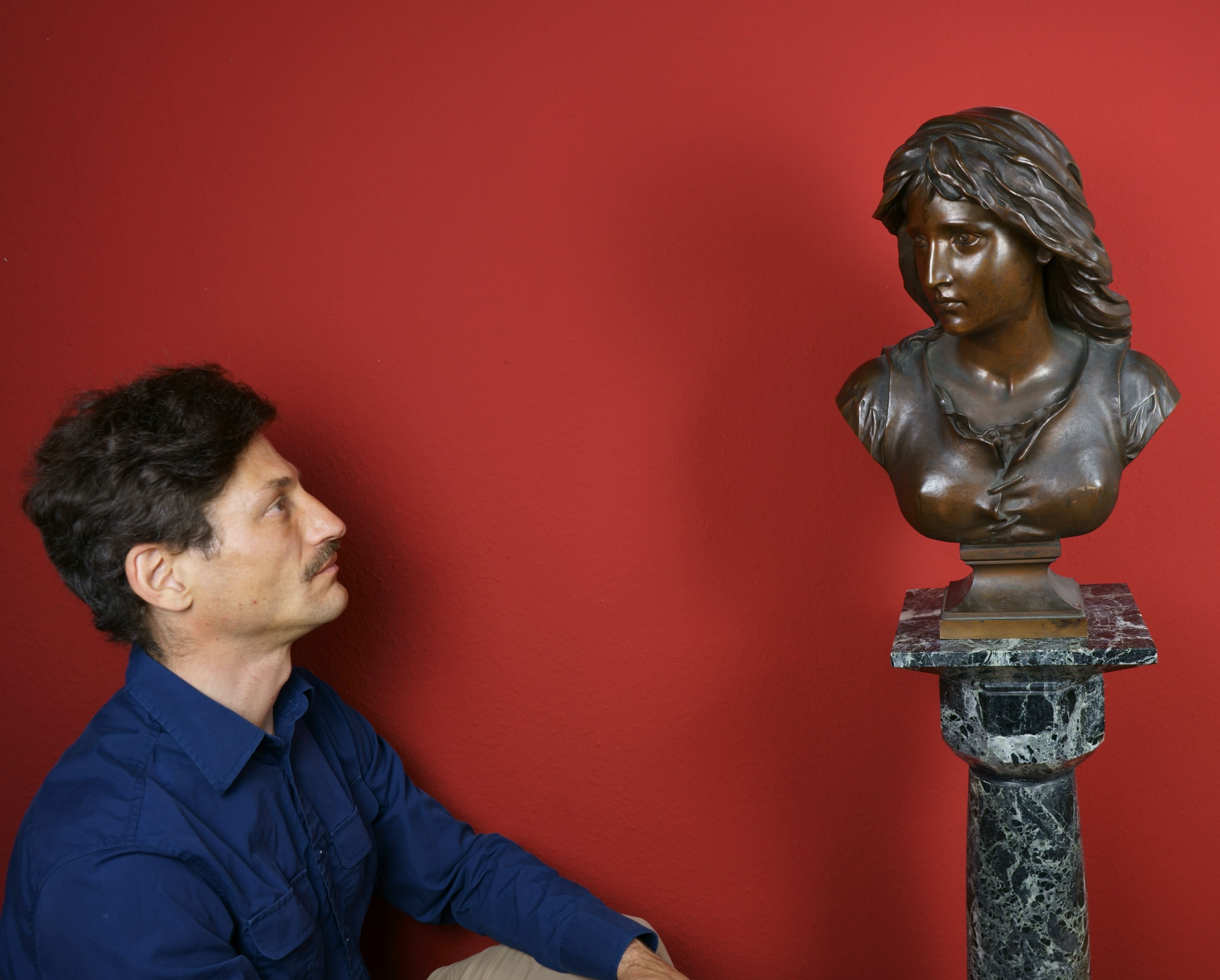
About the Seller
5.0
Gold Seller
Premium sellers maintaining a 4.3+ rating and 24-hour response times
Established in 2014
1stDibs seller since 2023
20 sales on 1stDibs
- ShippingRetrieving quote...Shipping from: Berlin, Germany
- Return Policy
Authenticity Guarantee
In the unlikely event there’s an issue with an item’s authenticity, contact us within 1 year for a full refund. DetailsMoney-Back Guarantee
If your item is not as described, is damaged in transit, or does not arrive, contact us within 7 days for a full refund. Details24-Hour Cancellation
You have a 24-hour grace period in which to reconsider your purchase, with no questions asked.Vetted Professional Sellers
Our world-class sellers must adhere to strict standards for service and quality, maintaining the integrity of our listings.Price-Match Guarantee
If you find that a seller listed the same item for a lower price elsewhere, we’ll match it.Trusted Global Delivery
Our best-in-class carrier network provides specialized shipping options worldwide, including custom delivery.More From This Seller
View AllS. Anton Patenkirchen / - The Home of the Landscape -
Located in Berlin, DE
Hans Thoma (1839 Bernau - 1924 Karlsruhe), S. Anton Patenkirchen, 1895. Algraph on strong wove paper, published by Breitkopf und Härtel in Leipzig as ‘Zeitgenössisches Kunstblatt Nr....
Category
1890s Realist Figurative Prints
Materials
Paper
Evening - The depth of the visible -
Located in Berlin, DE
Max Clarenbach (1880 Neuss - Cologne 1952), Evening. Etching, 18 x 41 cm (platemark), 33.5 x 57 cm (frame), inscribed "Abend" in pencil at lower left, signed and dated "M. Clarenbach. 28.III.[19]09". Framed and mounted under glass.
- Somewhat browned and slightly foxed.
About the artwork
The horizontally elongated etching depicts the panoramic view of a small town as seen from the other side of the river. There are gabled houses on the left and a mighty church spire on the right. The bourgeois houses and the large religious building indicate the urban character. These buildings are rendered in dark tones to emphasise the lighter row of houses in the centre of the picture, closer to the water. The chiaroscuro contrast creates two parallel planes that open up a space for the imagination of what the city could be. The imagination is stimulated by the almost entirely dark, barely recognisable buildings, while the arm of the river leading into the city further stimulates the imagination.
However, as the silhouette of the city as a whole is reflected in the water, the parallel planes are perceived as a band of houses that stretches across the entire horizontality of the etching and seems to continue beyond the borders of the picture. The reflection has almost the same intensity as the houses themselves, so that the band of buildings merges with their reflection to form the dominant formal unit of the picture. Only the parallel horizontal hatching creates the convincing impression of seeing water, demonstrating Max Clarenbach's mastery of the etching needle.
The water is completely motionless, the reflection unclouded by the slightest movement of the waves, creating a symmetry within the formal unity of the cityscape and its reflection that goes beyond the motif of a mere cityscape. A pictorial order is established that integrates everything in the picture and has a metaphysical character as a structure of order that transcends the individual things. This pictorial order is not only relevant in the pictorial world, but the picture itself reveals the order of the reality it depicts. Revealing the metaphysical order of reality in the structures of its visibility is what drives Clarenbach as an artist and motivates him to return to the same circle of motifs.
The symmetry described is at the same time inherent an asymmetry that is a reflection on art: While the real cityscape is cut off at the top of the picture, two chimneys and above all the church tower are not visible, the reflection illustrates reality in its entirety. The reflection occupies a much larger space in the picture than reality itself. Since antiquity, art has been understood primarily as a reflection of reality, but here Clarenbach makes it clear that art is not a mere appearance, which can at best be a reflection of reality, but that art has the potential to reveal reality itself.
The revealed structure of order is by no means purely formalistic; it appears at the same time as the mood of the landscape. The picture is filled with an almost sacred silence. Nothing in the picture evokes a sound, and there is complete stillness. There are no people in Clarenbach's landscape paintings to bring action into the picture. Not even we ourselves are assigned a viewing position in the picture, so that we do not become thematic subjects of action. Clarenbach also refrains from depicting technical achievements. The absence of man and technology creates an atmosphere of timelessness. Even if the specific date proves that Clarenbach is depicting something that happened before his eyes, without the date we would not be able to say which decade, or even which century, we are in. The motionless stillness, then, does not result in time being frozen in the picture, but rather in a timeless eternity that is nevertheless, as the title "Abend" (evening), added by Clarenbach himself, makes clear, a phenomenon of transition. The landscape of the stalls is about to be completely plunged into darkness, the buildings behind it only faintly discernible. The slightly darkened state of the sheet is in keeping with this transitional quality, which also lends the scene a sepia quality that underlines its timelessness. And yet the depiction is tied to a very specific time. Clarenbach dates the picture to the evening of 28 March 1909, which does not refer to the making of the etching, but to the capture of the landscape's essence in the landscape itself.
If the real landscape is thus in a state of transition, and therefore something ephemeral, art reveals its true nature in that reality, subject to the flow of phenomena, is transferred to an eternal moment, subject to a supra-temporal structure of order - revealed by art. Despite this supratemporality, the picture also shows the harbingers of night as the coming darkening of the world, which gives the picture a deeply melancholy quality, enhanced by the browning of the leaf.
It is the philosophical content and the lyrical-melancholic effect of the graphic that give it its enchanting power. Once we are immersed in the image, it literally takes a jerk to disengage from it.
This etching, so characteristic of Max Clarenbach's art, is - not least because of its dimensions - a major work in his graphic oeuvre.
About the artist
Born into poverty and orphaned at an early age, the artistically gifted young Max Clarenbach was discovered by Andreas Achenbach and admitted to the Düsseldorf Art Academy at the age of 13.
"Completely penniless, I worked for an uncle in a cardboard factory in the evenings to pay for my studies.”
- Max Clarenbach
At the academy he studied under Arthur Kampf, among others, and in 1897 was accepted into Eugen Dücker...
Category
Early 1900s Realist Landscape Prints
Materials
Etching
$540 Sale Price
20% Off
Southern German summer landscape / - The profile of the landscape -
Located in Berlin, DE
Hans Thoma (1839 Bernau - 1924 Karlsruhe), Southern German summer landscape, around 1897. Algraph on strong wove paper, published by Breitkopf und Härtel in Leipzig as ‘Zeitgenössisc...
Category
1890s Realist Figurative Prints
Materials
Paper
At the pond / - The longing of the landscape -
Located in Berlin, DE
Hans Thoma (1839 Bernau - 1924 Karlsruhe), At the pond, 1897. Algraph on strong wove paper, published by Breitkopf und Härtel in Leipzig as ‘Zeitgenössisches Kunstblatt Nr. 148’, 23....
Category
1890s Realist Figurative Prints
Materials
Paper
Woodland / - The Inner Drama of the Landscape -
Located in Berlin, DE
Eduard Peithner von Lichtenfels (1833 Vienna - 1913 Berlin), Woodland, 1884. Watercolor and pen and ink on drawing paper, 30.4 cm x 22.5 cm, signed, dated and inscribed by the artist...
Category
1880s Landscape Drawings and Watercolors
Materials
Paper
Late Summer River Landscape / - Realistic Impression -
By Jan Hillebrand Wijsmüller
Located in Berlin, DE
Jan Hillebrand Wijsmuller (1855 Amsterdam - 1925 ibid.), Late Summer River Landscape, oil on canvas, relined, 34 x 56 cm (inside measurement), 43 x 64 cm (frame), signed J[an] H[illebrand] Wijsmuller at lower right.
- in good condition, the frame with isolated bumped spots
- Realistic Impression -
About the artwork
The panoramic landscape format shows a river landscape, with the course of the river, which curves to the right, leading the eye into the depths of the picture and tempting it to continue the landscape in the imagination beyond the visible area. At the same time, however, the fact that the landscape is not visible through the bend in the river focuses our gaze on the entirety of the landscape depicted, without prompting us to focus on distant details. Accordingly, the brushstroke is not designed to render details with realistic precision. In the front left area of the river there is even a completely free brushwork, trained by Impressionism, which nevertheless remains committed to representational and convincingly suggests the movement of the water.
Regardless of the distance of the observer, the entire picture is painted with the same broad brushstroke, so that the landscape is given as an impression. And yet this impression is not ephemeral, as in the case of French Impressionism, to put it exaggeratedly, but reveals to us the essence of the landscape in all its richness. This is why the Dutch variant of Impressionism is always also a realism, although the pictures appear less progressive, but still contain a dimension of landscape painting that is lost with progress.
In the impression, the reality of the landscape is revealed, and this happens as we experience the landscape in the visual impression. Wijsmuller does not depict houses or people in order to allow the experience of the landscape to fully unfold. The experience is determined first and foremost by the river, which does not flow into the picture from our point of view, but towards us. Where the river begins to bend, the water is churned by a rapids. Toward us, the riverbed widens and the water comes to rest, covering the entire width of the foreground like a mirror.
The stillness of the water corresponds to the evening mood of the late summer landscape, in which the warm tones of the evening light blend with the yellow and brown tones of the plants. A gentle, almost idyllic reality, carried by the brushstroke, yet animated by a liveliness that is also made visible by the brushstroke. The broad, dynamically placed brushstrokes evoke the movement of the treetops and animate even the immobile reeds, while the trunks on the right bank, executed in virtuoso white strokes that seem like markings, make the sunlight shine. On the other bank, a carpet of light also spreads out, its energetic effect again expressed in the brushstroke. The dynamic of the landscape is further enhanced by the complementary color contrasts between the greens, yellows, and browns on the one hand and the blue of the all-encompassing sky on the other. A contrast that is intensified by the reflection in the water.
The evening coming to rest of the landscape is thus at the same time an all-encompassing contrasting and yet in itself harmonious movement. This reality becomes accessible to us as an experience in the impression of the landscape.
About the artist
Jan Hillebrand Wijsmuller entered the Royal Academy of Arts in Amsterdam in 1876 and studied under the innovative Professor August Allebé, who was famous for the Amsterdam Impressionism, also known as the Allebé School.
In 1877, Wijsmuller transferred to the Hague Academy of Art, and thus to the Hague School, and then completed his studies at the Brussels Academy of Art. Returning to the Netherlands, Wijsmuller opened his own studio in Amsterdam.
In 1883 he won the prestigious Young Artist Award, donated by Willink van Collen, which made Wijsmuller a well-known and sought-after artist.
Wijsmuller was a member of the Societät Arti et Amicitiae Amsterdam and the Pulchri Studio in The Hague.
Wijsmuller belongs to the second generation of the Hague School. While Vincent van Gogh described the protagonists of the first generation to his brother Theo as "the great gray people," the second generation, and Wijsmuller in particular, used a much more colorful palette. His oeuvre makes him a major player in Dutch Impressionism...
Category
1890s Impressionist Landscape Paintings
Materials
Canvas
$3,540 Sale Price
20% Off
You May Also Like
View of the River - Etching by George-Henri Tribout - Early 20th Century
By Georges-Henri Tribout
Located in Roma, IT
View of the River is an original artwork realized by George Henri Tribout.
Original etching on paper glued on cardboard.
Signature on the lower right corner.
George Henri Tribout ...
Category
1930s Modern Landscape Prints
Materials
Etching
View of Arona
By Dominique Vivant
Located in Middletown, NY
Denon, Baron Dominique Vivant. View of Arona.
Paris: 1788.
Etching on light cream wove paper, 5 1/2 x 8 1/2 inches (140 x 215 mm), full margins. Some...
Category
Late 18th Century French School Landscape Prints
Materials
Handmade Paper
A View of Scarborough, England: A Framed 19th C. Engraving After J. M. W. Turner
By J.M.W. Turner
Located in Alamo, CA
This beautiful 19th century framed engraving "Scarborough" by W. Chapman is based on an original painting by the renowned British artist J.M.W. Turner. It was published in London by ...
Category
Mid-19th Century Romantic Landscape Prints
Materials
Engraving
View of Semlin - Original Lithograph - 19th Century
Located in Roma, IT
View of Semlin is an Original Litograph realized by an unknown artist in 19th Century.
The little artwork is in good condition.
No signature, title in Yugoslawien.
Category
19th Century Land Figurative Prints
Materials
Lithograph
View of Malaga - Original Lithograph by Eigenthum d. Verleger - 19th Century
Located in Roma, IT
Ancient View of Malaga is an original lithograph on paper realized by Eigenthum d. Verleger in The 19th Century.
Signed on the plate on the lower right corner.
Original lithograph on paper.
Titled on the lower center.
Good condition
An impressive landscape...
Category
19th Century Modern Landscape Prints
Materials
Lithograph
View of the Port of Ripetta - Lithograph - 20th Century
Located in Roma, IT
View of the Port of Ripetta is an original Lithograph, realized by an anonymous artist in the 20th Century.
The status of preservation Good.
The artwork is depicted skillfully thro...
Category
20th Century Modern Figurative Prints
Materials
Lithograph
More Ways To Browse
Pilgrim Century
Michele Cascella
N Currier Lithograph
Robert Stanton
Roger Muhl
Andrew Wyeth Poster
Color Palette Tiffany Blue
Elmer Schooley
Mcknight Serigraphs
Petra Antique
Sncf Dali
Donald Sultan Orange
John Frederick Lewis
Thomas Mcknight Serigraph
Yoshida Hiroshi
Canaletto Engraving
Ernest Roth Etching
Hawaiian Prints Webber
